Buffy the Vampire Slayer and Marian symbols
Buffy the Vampire Slayer and Marian Symbols
Marian Symbols in the Buffy the Vampire Slayer Television Series on the WB
- Michael P. Duricy
"Look, folks, you may be hot stuff when it comes to demonology or whatever, but when it comes to Mary and the Media, I'm the Slayer." [paraphrasing Cordelia in Halloween]
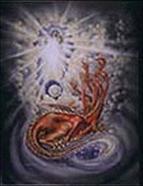
But seriously folks, I'd like to thank a number of my colleagues in the Buffademy for their assistance during the preparation of this paper. From the University of Dayton: Erica Coe; Bill Fackovec; Emily Hicks; and Fred Jenkins. And, from around the world: Rebecca Beirne; Tanya Cochran; Naomi Hetherington; John Pungente; and Jana Riess. Many thanks, also, to the many other people who have helped me with this project in some way.
In 2000, I completed a thesis on The Virgin Mary in Film. One of the areas studied was the brief but explicit use of Marian symbols in a great many films, most of which had very limited religious content. From the frequency of examples over time and across national boundaries, I concluded that certain implications have become conventional for using these episodic Marian signifiers: indicator of death or possible death; comparative standard for measuring the virtue or vice of a character; opponent of the demons; analogue of the female romantic lead; dea ex machina; and Catholic or ethnic artifact. There is one final convention involving the Marian symbol. Brief, but explicit, Marian content is sometimes used to identify a symbolic Marian character.
I, personally, did not start watching BtVS until its fifth season on the WB, savoring the pleroma of the Buffyverse only through reruns. Hence, I had absorbed the above hermeneutic from my general research before engaging myself with Buffy Studies. Though casual observers may not have noticed [due to the brevity of their appearance], Marian symbols were overtly shown rather frequently in BtVS. In my opinion, the purpose for using this episodic content corresponds to the above conventions, already long established by a history of use in the media of social communication.
Speaking of 'purpose', implies studying the intent of the author(s). However, I have found little public commentary about my topic from the production team, and have had no success in privately contacting anyone involved. In this regard, any help from my estimable colleagues in the international field of Buffy Studies would be much appreciated.
Still, I contend that we may safely assume that use of Marian symbols in BtVS operates from an awareness of the communicative norms established by convention in the industry. The fact that Joss Whedon is a third-generation media professional bolsters this argument.
Dramatic literature and performances routinely use brief and subtle devices to create mood or add depth. Critical reviews note the presence and importance of ‘back stories,’ subtexts, and mise-en-scene. The latter seems most relevant to our topic, as the episodic Marian symbolic content in BtVS most frequently involved shots of a Marian statue in the background, used much like a stage prop. Other religious symbols (e.g. candles, angels, crosses, churches) likewise appear.
Also, there are some clear examples of the BtVS writers using brief background shots as subtle allusions. In Lovers' Walk, we see a brief shot of Angel reading Sartre's La Nausee. The novel shows Sartre’s main character struggling with impressions of the meaninglessness of human existence. The brief, but explicit, shot of this book creates a linkage between Sartre’s protagonist, Antoine Roquentin, and Angel, who faces the same concerns.
A similar example, closer to our topic, was pointed out to me by Dr. Jana Riess, who noted that images in Faith’s room resemble icons of Shiva, the Hindu god of destruction. This establishes a "linkage" with Faith, who lives as if she idolizes Shiva, by her destructive acts. This example establishes a precedent for the sort of communicative intent which may be expected from the appearance of visual props, including images of the Virgin Mary.
It can not be denied that communicative intent is involved in the appearance of the audible and visual content in any scripted drama. Dialog is the result of conscious effort on the part of a screen writer. Statues and medals are brought in from a prop room. Even material which may accidentally be captured during filming, must still survive the critical eye of an editor or be lost on the cutting room floor.
In addition to these practical considerations, let me add that the effect of episodic visual content was studied at the theoretical level by Kuleshov and Pudovkin in the 1920s. Kuleshov demonstrated the importance of what came to be known as the "Kuleshov effect," with his celebrated experiment in which the impassive face of Ivan Mozhukin, when juxtaposed with a bowl of soup, a corpse in a coffin and a child with a toy bear, appeared to register hunger, grief and joy respectively. This effect is thought to occur even when the linkage occurs via extremely brief scenes. The phrase "subliminal messages" is commonly used to refer to these effects.
To further reduce any skepticism about the establishment of the above conventions as generally established norms, note a few examples of the above Marian conventions from some well-known films:
Indicator of death or possible death
In Bresson's Diary of a Country Priest, the title character, while dying, clutches his Rosary.
Analogue of the female romantic lead
An example from Leo McCarey's 1956 An Affair to Remember: While leading lady, Deborah Kerr, visits the grandmother of her romantic interest, Cary Grant, they spend time in the matriarch’s chapel. As Kerr bows her head, covered with a wide-brimmed hat which suggests a halo, Grant alternates his gaze from Kerr to an image of the Virgin Mary, making clear the parallel the Director wishes to suggest.
Catholic or ethnic artifact
There are a number of films in which “Marian symbols” are shown in the presence of characters with distinct ethnic backgrounds, primarily Irish, Hispanic and Italian. For example, in West Side Story, we know that Maria and her family are Catholic from the Marian statue in her bedroom; but this fact is subordinate to their being Hispanic, a point of major import to the plot.
Comparative standard for measuring the virtue or vice of a character
In the classic 1939 Hunchback of Notre Dame, Esmerelda, played by Maureen O'Hara in her screen debut, is awed and humbled by her first exposure to a statue of Mary in the great French Cathedral. Jean Frollo, Chief Justice of Paris, played by Cedric Hardwicke, appears and orders her to leave as unworthy. While O'Hara pours out her concerns before the statue with beaming face upturned, Hardwicke stares with downcast eyes at the object of his lust. It is clear who wins the sympathy of the Virgin Mary, and of the audience.
Dea ex machina [i.e. miraculously manufacturing a happy ending from difficult circumstances]
In the conclusion to the animated Hunchback of Notre Dame (1996) from Disney studios, the famous Cathedral comes alive, rescuing the beset heroes by delivering the villain to the demons he has invoked in an earlier scene.
Opponent of the demons
The clearest example can be seen in Friedkin's The Exorcist (1973). Early on, a number of eerie incidents subtly suggest the presence of unseen foes. However, the demons make their presence felt by desecrating a statue of Mary in a Catholic parish and murdering a man the same night. Having revealed themselves through their hatred of the Holy Virgin, the demons can no longer hide, and manifest themselves in a host of explicit ways through the remainder of the story.
To identify a symbolic Marian character
In Mick Garris' made-for-television miniseries The Stand (1994) we have a Marian type in Mother Abigail Freemantle, played by Ruby Dee, a kind and devout elderly black woman who becomes spiritual mother to an ersatz community of survivors after a biological holocaust. Like the Mary of cinematic convention, Abigail becomes an active opponent of her people’s wicked foes led by the demonic, Randall Flagg. Even more suggestive, when Mother Abigail leaves the community to go on retreat, its leaders gather around a statue of Mary to plan their defense against the unprovoked aggression which they expect from their uncivilized foes. In this sequence, Mother Mary and Mother Abigail are interchangeable!
Having presented the above conventions as hermeneutical apparatus, there is actually little left for me to add. Applying this heuristic for analysis of BtVS, or any particular media product, follows a fortiori, for the most part. It is a bit like Sherlock Holmes’ situation after explaining, in detail, the logical inferences which allowed him to know a great deal about a client at first sight.
Sherlock Holmes' quick eye took in my occupation, and he shook his head with a smile as he noticed my questioning glances. "Beyond the obvious facts that he has at some time done manual labor, that he takes snuff, that he is a freemason, that he has been in China, and that he has done a considerable amount of writing lately, I can deduce nothing else."
"How in the name of good fortune did you know all that, Mr. Holmes?" he asked. "It's true as Gospel, for I began as a ship's carpenter."
"Your hands, my dear sir. Your right hand is quite a size larger than your left. You have worked with it, and the muscles are more developed."...
"What about China?"
"The fish that you have tattooed immediately above your right wrist could only have been done in China. I have made a small study of tattoo marks and have even contributed to the literature on the subject. The trick of staining the fishes' scales of a delicate pink is quite peculiar to China. When, in addition, I see a Chinese coin hanging from your watch-chain, the matter becomes even more simple."
Mr. Jabez Wilson laughed heavily. "Well, I never!" said he. "I thought at first that you had done something clever, but I see that there was nothing in it after all."
"I begin to think, Watson," said Holmes, "that I make a mistake in explaining. 'Omne ignotum pro magnifico,' you know, and my poor little reputation, such as it is, will suffer shipwreck if I am so candid."
[from The Red Headed League by Sir Arthur Conan Doyle]
My poor little reputation as a Buffy Scholar may suffer a like fate. Everything just said, has come from simple observation of overt details in many films, like Holmes' monograph on tattoos. Everything that now follows, is simple application of the catalogued norms to the subject at hand, much like the Chinese fish. After presenting my findings in class, I always encourage my students to try it at home [pick any movie or TV show ... really!].
I am leaving some room for further research. This presentation is limited to episodes first shown on the WB. This allowed for comprehensive treatment since all were available on DVD as this paper was prepared. An appendix could be done studying the UPN episodes as well as the Angel series [and any other spinoffs or movies to come]. I have ignored the 1992 pilot film completely [though I find that Kristy Swanson’s slayer has a charm all her own]. Simply from casual observation, I noted several instances of episodic Marian content in BtVS on UPN, but can recall none on AtS. Also, given that these brief, but explicit, uses of Marian symbols is extremely widespread, and reflects broadly accepted conventions, it should be noticed in critical studies of media products like BtVS. However, there has been next to nothing in the literature which I have examined [e.g. use Google to search slayage.tv for the phrase "virgin mary"].
During the twelve episodes of the abbreviated first season, I found no content which could definitely be determined as Marian. Xander wore a medal, probably religious, in many episodes which I could not identify [Any help?]. Perhaps, the image of Angel holding the drowned slayer in Prophecy Girl might be seen to resemble the famous Pieta of Michelangelo. Buffy certainly played a Christ figure in that episode. So Angel was the Marian figure? Also, in Out of Mind, Out of Sight, Cordelia is elected as May Queen. Though Catholics developed a custom of honoring Mary during the month of May (e.g. crowning her statues), the name of the month, crowning a girl as May-queen, dancing around the may-pole, etc, have nothing to do with Mary historically and traditionally. [cf. Attwater's A Dictionary of Mary (1955)]. Given that Sunnydale High is a public school, we may assume the same of their May-queen customs. However, many people (especially older Catholics) will certainly recall the Marian connotations of the term May-queen. Since that is the case, it seems relevant to me that Buffy mentions holding the same office at her previous school. She adds: "Well, we didn't call it "May Queen," but we had the coronation, and the dance, and all that stuff. It was nice." Keep her comment in mind for later.
Season two offered a full complement of 24 episodes, and many instances in which a Marian symbol was presented. In the opening shot of the first episode, When She Was Bad, we see a statue in a cemetery which might represent the Virgin Mary. This would be consistent with the aforementioned convention associating Marian symbols with death.
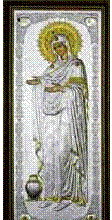
In Part I of What’s My Line?, the burial crypt of Josephus Du Lac contains another statue which also appears to be Marian. Specifically, it represents an iconographic motif called Gerondissa [above].
We are told: "He belonged to a religious sect that was excommunicated by the Vatican at the turn of the century." Du Lac's Catholic ties make the Marian identification likely, even though a longer and clearer shot would be necessary for certainty. Still, this would be another example in which Marian symbols are linked with death. Of course, this use would also be consistent with the convention associating Marian symbols with Catholics. However, in this case, Du Lac's faith seems largely irrelevant. It is the allusion to death that clearly seems relevant here.
This brings up an important point. There is a certain layering, or interdependence related to the conventional uses of Marian symbols. Rosaries, statues, Marian hymns, etc., are most commonly associated with Catholics, and, by extension, with people whose ethnic background derives from regions with large Catholic populations (e.g. Italy, Ireland). Were Du Lac not identified as Catholic, it would make more sense to play the death angle with other readily recognized non-sectarian symbols (e.g. bag pipes, Amazing Grace, headstones, candles, etc.)
In Part II, explicit Marian symbols appear during action in an abandoned Catholic church. Among many statues and symbols, we see a statue of the Madonna and Child. Recall, of course, that episodic use of Marian symbols as Catholic identifier is one of the established conventions mentioned earlier. Recall also, the layering effect above, for there are other factors at work here.
It is not so much that the action takes place in a Catholic church. More to the point, it is taking place in a sacred place, the sort of environment that presents an antithesis to the performance of evil deeds. The scenes of contract killings which are intercut with the baptism of Michael Corleone's son in The Godfather are a powerful example of the same technique.
The Catholic connotations of the Marian symbol are merely the supportive background for the effect of another convention, one which establishes a comparative norm for viewing the virtue or vice of the actions of the characters. This is supported by dialog from the episode.
Giles: "There are forty-three churches in Sunnydale? (pulls out a roll of mints) That seems a little excessive." (tears off some wrapping)
Willow: "It's the extra evil vibe from the Hellmouth. Makes people pray harder."
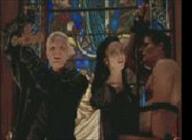
There is still more important Marian content in this episode. At the front of the church, behind the altar, is a stained glass image of Mary portrayed as the Woman of Rev. 12 [above].
The Scripture goes as follows: "And a great sign appeared in heaven, a woman clothed with the sun, and the moon under her feet, [emphasis mine] and upon her head a crown of twelve stars." [Apoc. 12:1].
This particular image is important for several reasons. It is of special importance to Catholics in Spain, as a consequence of the history of their religious wars with Islamic invaders. In Rev. 12, the woman, sometimes accommodated to Mary by Catholics, is at war with evil forces, diabolically evil forces: "And when the dragon saw that he was cast down to the earth, he pursued the woman ..." [Rev. 12:13].
I believe that this image was chosen in order to represent the milieu of Southern California, which was strongly influenced by Catholic missionaries from Spain during its founding. Other images which recall these missionary roots, appear in many episodes. For example, the monks opposing Glory [aka Glorificus] are dressed as Franciscan friars.
What all this suggests is that, in the first instance, the Marian symbols shown are an ethnic artifact deriving from the Spanish Catholic heritage of Southern California. From there, the other conventional connotations appear as layerings atop this foundation.
Yet, one needn't go far to find other layers. In this very stained-glass image of Rev. 12, we also see the convention of Mary as enemy of the demons [and Sunnydale is, quite literally, full of them!]. With the use of this image, the writers show their awareness of this convention and their willingness to exploit it. This will play a very important role in analyzing the meaning of the show as we proceed.
As a final comment on this episode, note that in the concluding scene, our heroine meets with Kendra, her colleague. Buffy is wearing a necklace of beads which holds a cross. Could this be a Rosary? With all the other Marian images in this episode, why doubt it?
In Surprise, a small Marian statue is visible in Angel's crypt. Like the statue in Du Lac's burial chamber, this image recalls the conventional association of Marian symbols with death. Also, in this episode, we again see Buffy wearing a cross hanging from a rosary-like chain of beads. She wears a similar necklace in Go Fish as well.
In Part I of Becoming, Angelus and Drusilla meet in church [apparently Catholic or Anglican]. There are religious statues, though I could not clearly identify any as Marian.
However, there is a scene in which Angelus impersonates a priest and hears Drusilla's confession. He cruelly tries to drive her to despair, telling her that she is surely headed for damnation: "Yes! You're a spawn of Satan. All the Hail Marys [emphasis mine] in the world aren't going to help. The Lord will use you and smite you down. He's like that." Like the church in What’s My Line II, this sacred setting, including the sacramental event and the reference to prayer, present a standard of goodness against which the depth of Angelus' wickedness becomes apparent by contrast. The above dialog is the only audible Marian content which I noted in the series.

In Part II of Becoming, after mortally stabbing Angel, Buffy steps back slowly; and we briefly see a partial view of a stone statue behind her, adorned by a blue sash. We are already familiar with the appearance of Marian statues in the crypts and cemeteries frequented by vampires in the series. In this case, it appears that we are briefly shown one of Our Lady of Lourdes [above]. And with this episode, we come to the conclusion of the second season
Season Three presented a full 24-episode contingent. In Revelations, we see yet another Marian statue in a cemetery, this one in the style known as Adolorata (i.e. Our Lady of Sorrows--below).
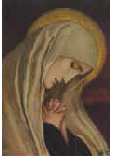
In this episode, we also see Cordelia wearing a medal, which might be a religious medal (e.g. "Miraculous Medal"). Perhaps, it is the same medal worn by Xander in previous episodes, making its way to Ms. Chase as a consequence of their romantic trysts.
She appears to wear the same medal in several other episodes in season three: Homecoming; Band Candy; Lovers’ Walk; Amends; Helpless; The Zeppo; Bad Girls; and Doppelgangland. We also see Willie the Snitch [host of a tavern for demons], wearing what appears to be a religious medal in Amends. However, in no instance was I able to clearly identify these medals. It is worth noting that Amends is set at Christmastime, but religious displays form no part of the mise-en-scene.
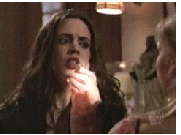
In This Year’s Girl, we see a statue of a seated female figure in the living room of Buffy’s house [above]. This resembles a Marian motif called the ‘enthroned virgin’ [aka Basilissa, Maesta]. However, this particular style of statue is modeled on pre-Christian representations of Isis. Hence, identification as a Marian symbol is ambiguous. A similar statue is also shown in Giles' house in Wild at Heart and Pangs.
And there is a similarly ambiguous poster shown in Xander's basement. The picture shows a woman in ornate robes with upraised hands. There is a resemblance to the Orans of christian iconography, but the appearance seems closer to an oriental mercy goddess like Kuan Yin. Dr. Riess examined the image at my request, affirming it’s similarity to Kuan Yin, but admitting uncertainty.
In Helpless, there is a possibly-Marian statue in the area in which Buffy's Mother, Joyce, is held captive. Though I could not identify the statue with certainty, it would be consistent with the convention of presenting a standard of goodness in contrast to the evil of the vampire captor. In fact, most traditional religious images would suffice in this regard.
The situation is similar in Bad Girls. There is a small statue in a cemetery which might be Marian, but could not be positively identified. If Marian, it is still another example of the BtVS writers adhering to the conventional link between Marian symbols and the dead.
After Doppelgangland, there was no Marian content in remaining six episodes of the third season. However, The Freshman, which opened season four saw the return of the Virgin Mary to the Buffyverse. In the opening sequence of this episode, Buffy patrols a cemetery, talking with her friend, Willow. They walk past a statue of Mary (and also one of an angel). The evidence just piles up of the writers using the convention linking Marian symbols with death and dying.
In the opening sequence of Something Blue, we have a very similar scene. Buffy patrols a cemetery talking with Willow; and they pass a statue of Mary. Shortly thereafter, they are attacked by a vampire. In The Freshman, a vampire also appears during their stroll, but simply runs off. Interestingly enough, also in the background for this scene is a headstone inscribed, "Mary Christian." Make of this what you will. I'm open to suggestions.
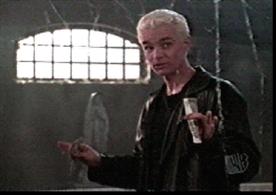
In The I In Team episode, we see a Marian statue inside the burial crypt in which Spike resides [above]. It is shown again in the episode which follows, Goodbye Iowa and also in Restless.
Just more of the same, Marian symbols near the dead or dying. It appears to represent the standard iconographical motif of the Adolorata, or perhaps, merely an orante, with hands folded in prayer.
Near the conclusion of Who Are You?, we briefly see a set of small statues of the Holy Family (i.e. Jesus, Mary and Joseph) in the back of a Catholic church in which vampires are holdings parishioners hostage. Other religious symbols are shown as well. Here the Marian symbol functions as a Catholic identifier. In this sequence, we learn that Riley Finn attends the parish. Of course, his name is Irish, and the symbol takes on the added function of ethnic artifact. These are both established conventions discussed earlier. But we also see the layering effect mentioned before. Since we are placed in an Irish Catholic milieu, it is consistent and appropriate to use the Marian symbol as a standard of goodness for measuring the virtue and vice of characters in the vicinity. The hostages are good people, there only to worship. The vampires are villains looking for victims, undeterred by the presence of sacred space.
Had they not set the action in a Catholic church, the writers would have been compelled to use a non-sectarian symbol as the standard of goodness for comparison. However, outside of a recognized Catholic or similar ethnic context, film-makers have other conventions for creating similar effects. For example, when Arnold Schwarzenegger’s killer cyborg crushes a child’s doll in The Terminator, the gravity of his wickedness is no less apparent than when hit men shatter a statue of Mary on route to a murder in Godfather Part III. In large part, this study is shedding light on some of the tools used by Whedon and company as craftsmen in the cinematic trade.
Near the end of Superstar, we find a now-familiar, statue of Mary in one of Sunnydale's many cemeteries. The next episode, Where the Wild Things Are?, opens with Buffy and Riley fighting, respectively, a demon and a vampire in a cemetery. The ubiquitous graveside Madonna is also shown. However, this is an unusual scene, not filmed in linear mode. The fight scenes with Buffy and her beau are intercut with scenes of the intimate contact which follows. This suggests an interesting insight drawn from our Marian conventions.
Though the bulk of the Christian world believes [as required dogma] that Mary of Nazareth never knew a man intimately, as indicated by the universal usage of "the virgin Mary" as her appellation, my study of hundreds of films revealed that the Marian symbol has often been used as a convention by which to identify a female romantic lead. Perhaps, this entered common use in Western culture as a result of the Marian elements of the troubadour tradition of courtly love. In any case, the Marian symbol is often used to identify a female character as the focus of the development of a sexual relationship.
In these works, film-makers attempt a lateral transfer to those elements of Christian tradition which have seen Mary as "erotic ideal," the woman who attracts by her beauty. A recent example is found in Baz Luhrmann's contemporarily stylized Romeo and Juliet (1996). Marian images are scattered throughout Juliet’s house, including a statue in her bedroom. As strange as it may appear at first, it appears that the aforementioned scene from BtVS is another example of this technique. Even with 4 episodes to go, we have come to the end of symbolic Marian content from the fourth season.
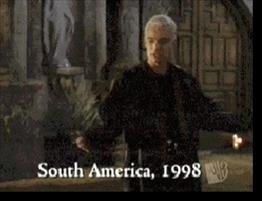
In season 5, the first definite Marian content appears in Fool for Love. On the lam abroad, Spike and Drusilla break up in front of a large statue of the Virgin Mary [above]. From the caption, we see they are located in Latin America, a region inhabited by many Catholics. So we have another example of the conventional usage of a Marian symbol as a Catholic and/or ethnic identifier. Atop this foundation, there may also be a secondary meaning which identifies the female romantic lead, in this case, Drusilla.
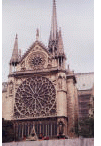
The following episode, Shadow, shows a rose window in shadow on the floor of a church through which a serpent demon passes while searching for "the key." The image at right is from Notre Dame in Paris. Rose windows were used in many of the great Marian cathedrals of Europe. Which begs the question, why do we see one in Sunnydale? By the way, in the same church we see stations of the cross on the walls, presumably with #4, Jesus Meets His Mother.
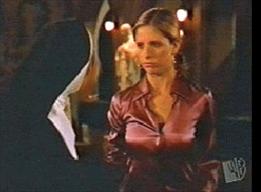
In Triangle, the show opens with Buffy slaying a vampire inside a convent for Catholic nuns. Of course, there are statues of Mary in a place like that, and the camera catches the one at left, showing Mary with her "Immaculate Heart" exposed. The typical conventions are at work here, as we have seen so many times already in the series. However, atop these foundations is another layer of meaning. Buffy is there to consider a celibate life. Both the statue and the sisters call to mind that vocation call and act as symbols showing what a character accepting that call would be.
In Forever, we witness the funeral of Buffy's mother, Joyce Summers, who died in the previous episode, The Body. At this point in the presentation, we might expect to hear about the obvious episodic Marian content in association with death. However, I did not see anything explicit while viewing the episode. Perhaps, this is not surprising, given that Buffy's family does not seem to be Catholic, or even particularly religious. Still, this convention was too strong to ignore. In the closing credits, Noor Shic was listed as "Lady with rosary!"
The rosary seems to appear again in Spiral, as clerics with the "Knights of Byzantium" are shown holding some sort of prayer beads. Similarly, the monks in No Place like Home, clad in the garb of Franciscan friars, also carried similar prayer beads. A crowned statue of a Spanish Madonna in Doc's shop which appears in The Weight of the World is the last of the clearly explicit Marian visual content in the WB series. As stated earlier, the Spanish missionary heritage seems to have been the foundation for the use of Marian symbols in the series.
But in the same episode, there seems to be a verbal allusion to Our Lady. When asked his motivations, Spike answers: "I made a promise to a Lady." Clearly, the tradition of courtly love is alluded to here, and its Marian component by extension.
Fans of the series know that plots may twist and turn a number of times before orienting on their final trajectory in a story arc. It appears that the series, in toto, manifested this technique. We have arrived at the series finale on the WB, The Gift. And we have also arrived at the last of the Marian conventions which my research uncovered, use of a brief, but explicit Marian reference to indicate a character among the personae dramatis who has some significant Marian characteristic. In both cases, "end stress" adds to importance of these findings.
In season 2, a stained glass image of Mary as the Woman of the Apocalypse established a linkage with Buffy as the enemy of demons using the Kuleshov effect. In The Gift, we see that seed grown to full stature.
In the first episode of the final season we learn, to everyone's surprise, that Buffy has a sister, Dawn. We will later learn that she is integral to this whole great concluding plot arc. Then in the season's fourth episode, we learn from rosary-bearing monks, that the world is about to be threatened by "the beast."
The term "beast" is used again by members of the "Knights of Byzantium," an ancient order sworn to oppose it. Here note that Byzantium was the capitol of the Christianized Roman empire, and that the logo of their armed forces [like our Uncle Sam] was the Marian icon at left, called Nicopééia (i.e. Who brings victory). The beast of the apocalypse, mentioned in the Book of Revelation in relation to thousand year epochs, is a familiar figure, especially discussed around the time of the recent millennial celebrations. Season five aired from September 2000 through May 2001 and may have worked off that influence.
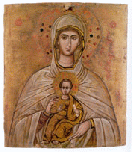
In any case, the writers truly went over the top in making their intentions clear. In the following exchange, from Spiral, Gregor is a general of the Knights of Byzantium:
GREGOR: What do you know of the beast?
BUFFY: Strong. Fast. Hellgod.
GREGOR: From a dimension of unspeakable torment.
BUFFY: A demon dimension. I know. She ruled with two other hellgods, right?
GREGOR: Along with the beast they were a triumvirate of suffering and despair. Ruling with equal vengeance. But the beast's power grew beyond even what they could conceive. As did her lust for pain and misery. They looked upon her, what she had become ... and trembled.
BUFFY: (nervously) A god afraid?
GREGOR: Such was her power. They feared she would attempt to seize their dimension for herself, and decided to strike first. A great battle erupted. In the end, they stood victorious over the beast ... barely. She was cast out. Banished to this lower plane of existence ...
In the Book of Revelation, three beasts are spoken of, coordinated into a triumvirate of sorts, each evil and destined for Hell. One, called The Dragon, is cast down to earth and makes war on The Woman, as discussed earlier. A detailed study comparing and contrasting the series descriptions of the beast with that of Revelation is beyond the scope of this paper. And it is not needed. The mass audience of the series will neither develop nor read such research. The message of the series hits hard and fast in the right half of the brain. Buffy is entertainment, not academe; and we've seen quite enough from which to make our conclusion.
What we may have suspected from earlier clues has now been made manifest. Buffy has been the mythic enemy of demons in a manner analogous to that which many Christians have seen in the Virgin Mary. The frequent use of explicit Marian symbols has kept a mysterious link in our minds throughout the series. And the last thing we take from its days on the WB is the image of Buffy as the Woman of the Apocalypse.
All About Mary includes a variety of content, much of which reflects the expertise, interpretations and opinions of the individual authors and not necessarily of the Marian Library or the University of Dayton. Please share feedback or suggestions with marianlibrary@udayton.edu.
